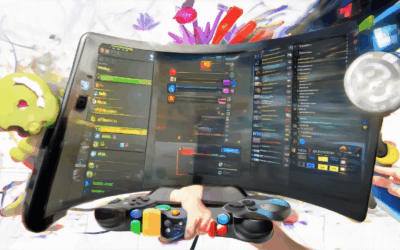The art of balancing within video games is a cornerstone of successful game design, shaping player experiences and maintaining game integrity. At its core, the in-game economy serves as a vital system, influencing gameplay dynamics and fostering engagement. However, achieving equilibrium in this complex ecosystem presents unique challenges that require meticulous planning and execution. This article delves into the intricacies of in-game economy balancing, exploring its fundamental concepts, the mechanics behind effective balancing, and the strategies developers employ to ensure fairness and enjoyment. By examining the challenges players and designers face, we’ll uncover best practices and real-world examples that highlight the evolution of this critical aspect of game development.

How to Balance Economy in Game
To achieve a balanced game economy, follow these organized steps:1. **Define Core Loop and Resources**: Start by identifying the primary mechanisms driving your game’s economy. Categorize key resources and visualize their inflows and outflows to ensure fairness and sustainability.2. **Monitor Resource Flows**: Use tools to track where resources come from (inflows) and where they are spent (outflows). This helps in identifying potential imbalances and areas needing adjustment.3. **Regular Analytics and Reporting**: Implement systems to monitor player behavior and economic activities. Utilize dashboards to track metrics like average earnings per player and transaction volumes.4. **Test with Real Players**: Conduct beta tests to gather feedback on the economy’s feel. Adjustments based on player experiences can prevent issues from escalating.5. **Adapt and Iterate**: Stay flexible by continuously refining the economy. Learn from successful games like League of Legends and Fortnite, applying their principles thoughtfully to your own game.6. **Communicate Changes Clearly**: Inform players about adjustments to maintain trust and transparency, fostering a positive gaming environment.By following these steps, you can create a balanced and sustainable game economy that enhances player experience.
What is an In-Game Economy?
An in-game economy refers to the virtual economic system within a video game that allows players to earn, spend, and trade virtual currency or items. These economies often mirror real-world economics, enabling players to acquire resources, exchange goods, and engage in transactions within the game environment.### Common Types of In-Game Currencies- **Gold/Coinage**: One of the most widely used forms of virtual currency, often used for purchasing items, services, or even real estate within the game.- **Coins**: Often used alongside gold, coins may have limited utility or be required for certain transactions.- **Points/Premium Currency**: Sometimes referred to as premium currency, these are often earned through achievements, purchases, or special events.- **Resources**: Includes materials like wood, stone, or ore that players gather to craft items.- **Energy/Credits**: Used to power abilities, upgrade equipment, or access exclusive content.### Why In-Game Economies MatterA well-designed in-game economy enhances gameplay by creating opportunities for strategy, trading, and social interaction. Players can buy, sell, or craft items, fostering a sense of achievement and engagement. Proper balance ensures fairness and prevents players from feeling overly powerful or disadvantaged.### Best Practices for In-Game Economies- **Dynamic Pricing**: Allow prices to fluctuate based on supply and demand to keep the economy lively.- **Player Feedback Loops**: Regularly survey players to adjust systems and prevent burnout.- **Balancing Act**: Ensure fairness by carefully managing the supply of valuable resources.- **Optional Microtransactions**: Offer optional purchases to enhance gameplay without disrupting progression.By thoughtfully designing in-game economies, developers can create immersive worlds that reward player effort and foster vibrant communities. For more insights into crafting engaging economies, visit our resource hub.### Future of In-Game EconomiesAs technology advances, in-game economies are expected to become more sophisticated, incorporating blockchain for secure transactions and NFTs for unique asset ownership. These innovations promise to revolutionize how players interact with virtual economies, making them more versatile and rewarding.
How Does Game Balancing Work?
Game balancing is a critical process in video game development aimed at ensuring a fair and enjoyable experience for all players. It involves carefully adjusting various elements of the game to maintain equilibrium, allowing players to engage with the title on equal footing while keeping the gameplay dynamic and engaging.### Key Components of Game Balancing1. **Difficulty Adjustment** – One of the primary aspects of game balancing is tailoring the difficulty level to suit the target audience. This ensures that the game isn’t too challenging or too easy, which could lead to frustration or boredom among players.2. **Win/Loss Conditions** – Clear and consistent win/loss conditions are essential for maintaining fairness. Players should understand the criteria for victory and defeat, ensuring that no single factor dominates the outcome.3. **Economy Balancing** – In games that involve currency or resources, the economy must be carefully managed. This prevents any unintended advantages for specific groups of players and maintains a balanced progression system.4. **Game States and Pacing** – The various modes, maps, or challenges within a game must function smoothly. Proper pacing ensures that the game progresses at a comfortable rate, avoiding overwhelming or underwhelming experiences.### Implementation and Monitoring- **Iterative Testing**: Game balancing is an ongoing process that requires constant testing and refinement. Developers often rely on player feedback and analytics to identify imbalances and make necessary adjustments.- **Tools and Analytics**: Advanced tools are employed to track player behavior and performance, enabling developers to make informed decisions about parameter adjustments.- **Player Perception**: Beyond numerical balances, developers must consider how players perceive the game. Perceived fairness is just as important as actual balance, necessitating clear communication between developers and testers.### Industry Practices- **Dedicated Teams**: Many studios assign dedicated balance teams to oversee this critical aspect of game development.- **Metrics and Feedback**: Success is measured through metrics like player retention, win rates, and feedback surveys, which guide further optimizations.By thoughtfully addressing these elements, developers can create a game that offers a fair and rewarding experience, ensuring longevity and engagement for players.
What Does Balanced Mean in Gaming?
Balance in gaming refers to the state of equality among players, ensuring that everyone has a fair chance to succeed based on skill, effort, and strategy. A balanced game is one where no single player, team, or element has an unfair advantage over others.
Examples of Balanced and Unbalanced Games
Games like League of Legends and Dota 2 are known for their balance. Each hero has unique abilities and weaknesses, allowing for competitive yet fair matches. On the other hand, games like Overwatch can sometimes feel unbalanced if certain heroes dominate meta.
The Impact of Balance on Gameplay
A well-balanced game ensures that matches are fair and enjoyable. If a game is too unbalanced, it can lead to frustration, particularly if one team consistently wins due to overpowering items or abilities. Developers often spend considerable time tuning and adjusting games to maintain balance.
Types of Balance in Gaming
1. **Item Balance**: Ensuring that in-game items provide a fair challenge and progression for all players. 2. **Map Balance**: Designing maps that offer multiple paths to victory, preventing one route from being dominant. 3. **Hero Balance**: Balancing the strengths and weaknesses of each playable character to prevent overpowering.
Maintaining balance is crucial for creating engaging and fair gaming experiences. By understanding and addressing these aspects, developers can ensure that their games remain enjoyable and competitive for all players.
Learn more about game balancing and development tips at Indie Dev Games.
Why Is Game Balancing So Difficult?
Game balancing is a complex and multifaceted endeavor that involves ensuring fair and equitable gameplay experiences for all players. Here are the primary reasons why achieving perfect balance in video games remains such a significant challenge:1. **Multiple Variables**: Modern games often feature a vast array of variables, including weapons, abilities, characters, and game modes. Each of these elements can significantly impact the overall balance of the game, making it difficult to ensure that no single element dominates or becomes underpowered.2. **Intentional Imbalances**: Sometimes, game developers intentionally introduce imbalances to encourage specific playstyles or to create challenges for players. However, this approach requires careful management to prevent frustration and dissatisfaction among players.3. **Player Behavior**: Player behavior can unpredictably influence game balance. Players may discover powerful combinations, exploit weaknesses, or develop strategies that disrupt the intended balance. Designers must anticipate and mitigate these behaviors to maintain a fair playing field.4. **Testing and Iteration**: Achieving balance often requires extensive testing and iteration. Developers must continuously monitor gameplay, collect player feedback, and make adjustments to ensure that the game remains balanced over time.5. **Platform and Hardware Differences**: Games designed for multiple platforms or hardware configurations face unique balancing challenges. Differences in console setups, PC specifications, or mobile devices can lead to varied experiences, requiring tailored adjustments for each platform.6. **Competitive Play**: In competitive games, ensuring fairness is critical. Designers must anticipate and counteract potential exploits, cheats, or unfair advantages that players might discover or develop.7. **Updates and Patches**: Post-launch updates and patches present additional balancing challenges. New content, bug fixes, or player feedback can introduce new imbalances that require immediate attention.In summary, the difficulty in achieving game balance stems from the interplay of numerous variables, the necessity for continuous testing and adaptation, and the inherent complexities of catering to diverse player behaviors and hardware environments.
Is It Better to Have Balanced or Unbalanced Audio?
In audio systems, a balanced setup typically provides better sound quality due to reduced noise and improved signal integrity. Here’s a breakdown:
- Balanced Audio: – Pros: Reduces noise, enhances clarity, and prevents equipment strain. It handles feedback issues effectively by proper grounding, minimizing the risk of oscillations. – Cons: Requires matching impedances between components, which can be complex and costly.
- Unbalanced Audio: – Pros: Simpler setup, often cheaper, and easier to install. – Cons: May result in power loss, strain on equipment, and poorer sound quality due to weaker signals and increased noise.
For most applications, balanced audio offers superior performance and reliability. However, unbalanced systems may suffice for temporary or casual use where cost and complexity are concerns. Ultimately, the choice depends on the intended use and desired sound quality.




0 Comments